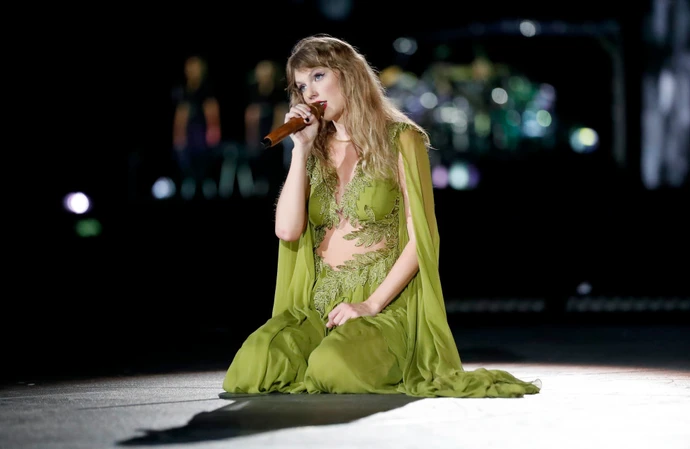The Tortured Poets Department: Messy or misunderstood?
A comprehensive look at the misunderstood nature of Taylor Swift's 11th studio album.

Despite achieving record breaking streaming and sales numbers, Taylor Swift's ‘The Tortured Poets Department’ received a mixed reception – by fans and critics alike – for being messy, insular and overly emotional.
The Baylor Lariat, the student newspaper of Texas' Baylor University, wrote: “As much as I wanted to like 'The Tortured Poets Department', Taylor Swift’s 11th album makes me feel like a tortured music journalist. Its high points — and it does have them — can’t save the rest of the 31-track behemoth of an album.”
This echoed a sentiment shared amongst some online, with fans claiming that they liked the album, though still backing the idea that Swift should have “brought on an editor” due to the interpreted disjointed nature of the final product.
For Swift, her skill is storytelling. Following on from the widespread acclaim of prior album 'Midnights', and praise for her musical departure on 'Evermore' and Folklore', was ‘The Tortured Poets Department’ a rare creative miss? Or was it all intentional? A record on which Taylor showed her dry humour, cynicism and filled with rage.
This is the misunderstood nature of 'The Tortured Poets Department'.
Chapter 1: The Context
To understand TTPD, we must first look at the context in which it was created. The LP came at a time of mass public scrutiny for Swift. Fresh off the heels of the end of her long-term relationship with actor Joe Alwyn, Taylor had a brief romance 1975 frontman Matty Healy.
Swift's dalliance with Healy was highly scrutinised, beginning with an appearance at a London 1975 show in late 2022, leading on to several paparazzi shots capturing the pair spending time with one another over the coming months, before their break-up in 2023. Fans and critics alike took to online spaces to criticise her decision in being linked to Healy, due to his rock star antics. It seemed the backlash towards Swift's complicity in relation to Healy was greater than the backlash directed at Healy himself.
Perhaps it was Swift's legacy prior to her connection with Healy that caused such an outpouring of criticism. For the most part, her image was that of a self proclaimed “good girl”, marketed in her early career as the ultimate girl next door, rising through the ranks from humble country roots, Taylor Swift – The performer – was untouchable. This narrative held by fans is ultimately indicative of the parasocial relationship problem in pop music in 2024. Audiences feel they know artists on a personal level, an effect only heightened by Swifts diaristic approach to storytelling.
While this bond between artist and fans has kept Swift not only relevant but more successful than ever 18 years into her career, we see the dark underbelly of the parasocial relationship in Swift's connection to Healy. When an artist who fans feel they know so personally behaves in a way perceived to be “out of character” or controversial, audiences can feel hurt on a personal level. Despite the fact that some may feel otherwise, no listener is ever able to truly know or understand Taylor Swift the person. But with an audience of millions and the whole world tearing apart every decision, there is little room for that person to be allowed to make mistakes without mass uproar.
This kind of pressure is undoubtedly insurmountable. Tortured Poets serves as an analysis of a real human being making mistakes and experiencing world shattering heartbreak, all while being held to an ever evolving, impossible standard and having every misstep analysed under a microscope.
'The Tortured Poets Department' is not just another break-up album, it is the culmination of a woman pushed to her breaking point.
Chapter 2: The Prolouge
Included in physical copies of 'The Tortured Poets Department' was a printed prolouge written by Swift, serving as a set-up for the narrative laid out over the course of the record. Although millions prefer to stream, an analysis of the prologue proved to be an integral lens for audiences to interpret this body of work.
'In Summation: Summary Poem' by Taylor Swift
"At this hearing
I stand before my fellow members of the Tortured Poets Department
With a summary of my findings
A debrief, a detailed rewinding
For the purpose of warning
For the sake of reminding
As you might all unfortunately recall
I had been struck with a case of a restricted humanity
Which explains my plea here today of temporary insanity
You see, the pendulum swings
Oh, the chaos it brings
Leads the caged beast to do the most curious things
Lovers spend years denying what’s ill fated
Resentment rotting away galaxies we created
Stars placed and glued meticulously by hand next to the ceiling fan
Tried wishing on comets
Tried dimming the shine
Tried to orbit his planet
Some stars never align
And in one conversation, I tore down the whole sky
Spring sprung forth with dazzling freedom hues
Then a crash from the skylight
Bursting through
Something old, someone hallowed, who told me he could be brand new
And so I was out of the oven
And into the microwave
Out of the slammer and into a tidal wave
How gallant to save the empress from her gilded tower
Swinging a sword he could barely lift
But loneliness struck at that fateful hour
Low hanging fruit on his wine stained lips
He never even scratched the surface of me
None of them did
“In summation, it was not a love affair!”
I screamed while bringing my fists to my coffee ringed desk
It was a mutual manic phase
It was self harm
It was house and then cardiac arrest
A smirk creeps onto this poet’s face
Because it’s the worst men that I write best
And so I enter into evidence
My tarnished coat of arms
My muses, acquired like bruises
My talismans and charms
The tick, tick, tick of love bombs
My veins of pitch black ink
All’s fair in love and poetry
Sincerely, The Chairman of The Tortured Poets Department”
The prologue, in essence, frames the entire album. Poetic, but also cuttingly self aware: Acting as both a dissection of Swift's romantic despair and an act of self-reclamation. Swift by nature is the curator of her own chaos, positioning herself here as simultaneously a witness and a participant, highlighting her two roles that exist in conflict for the narrative at hand: Lover and Villain, Muse and Martyr. The opening lines clearly set her intent, warning audiences not to expect the same cohesive analysis of heartbreak seen in her previous discography, rather a vivid and raw portrayal of a “poet” pushed to the edge. A reflection of a failed love with a fraught self awareness.
We see Swift address the cyclical nature of ‘Taylor Swift’ The performer: Love, loss and lyrical rebirth. Grappling with the contradictions that have shaped both her art and her identity.
Without this writing, the album runs risk of vast misinterpretation, the work is not to be viewed as a collection of isolated emotions, the tracks do not serve as standalone confessions – Moreover, Chapters in a cohesive, all be it chaotic, manifesto. A record that embraces it’s jagged edges, a refusal to sand down splinters for the sake of appearing polished.
The prologue does more than preface – it contextualises. Our first look at the true brilliance of 'The Tortured Poets Department'.
Chapter 3: Humour
Arguably the most overlooked aspect of the album itself is it’s humour and self-aware nature. While some lines may have appeared confusing to listeners without context, those in the know were able to decipher their comedic and discerning nature. When at breaking point, many call into memory the phrase “If I don’t laugh, I’ll cry”. This sentiment rings true throughout 'TTPD', in her self-proclaimed insanity Swift could not help but laugh. Perhaps her reflections also brought humour to the forefront, realising the extent of one’s actions when emerging from the delusions of love can feel humbling for the best of us.
Thematically, the dramaticism in presentation of 'Tortured Poets' feels like Swift herself turning to the camera and winking. While packaged in a pseudo Victorian aesthetic, fit with typewriters and a sepia filter, perfect for a true tortured artist, the final product feels hilariously self aware. Mocking it’s own concept as uppity and pretentious. This can be seen clearly in the records title track. One lyric reads, “You’re not Dylan Thomas, I’m not Patti Smith, This ain’t the Chelsea Hotel, We’re modern idiots”, dismissing the idea of self importance held by modern artists, particularly in the pop industry, attempting to build themselves up as contemporary greats.
"I think some things I never say, like who uses typewriters anyway,” another line from the title track, once again drawing humour from something that would later come to be adopted as part the albums visual identity.
When looking to other tracks, such as ‘But Daddy, I Love Him’ – a song told from the midst of mania, addressing the backlash toward Swift's association with the muse as it happens in real time – has more direct comedic elements. Such as the fourth wall breaking “I’m having his baby. No I’m not but you should see your faces," playfully subverting audience expectations, all while using her well known penchant for confessional songwriting to lampoon the very tropes she herself is credited for popularizing. Lines such as this one serve as an act of tongue in cheek defiance, a tone that is threaded throughout the record, allowing Tortured Poets to transcended its supposed bleak and melancholic overtones.
The double edged nature of Swift's intelligence lies in her self-parody – daring listeners to take her too seriously all while inviting them to do just that. The LP acts as a deconstruction of her own Mythos, drawing comedy from the idea of herself as a eternal tragic heroine, a narrative imposed by both critics and fans. Without the cycle of heartbreak into art, who is Taylor Swift? In ‘But Daddy I Love Him’ Swift is reclaiming this manic energy, reinterpreting it with a theatrical quality. It is dripping in irony. Blending humour with heartbreak in an act of rebellion – more a musical parody than an earnest diary entry, setting it apart from all of other undertakings in her discography. The self-deprecation does not diminish the weight of her experiences, it elevates it.
'The Tortured Poets Department' is less a portrait of despair, more a reclamation of absurdity inherent in fame. A lyrical balancing act of tragedy and comedy, with Swift dancing on the tightrope above.
Chapter 4: Rage and Fame
At the core of 'The Tortured Poets Department', above all else, is rage. Swift coined the album herself as “Female Rage: The Musical” when announcing its addition to her box office breaking 'Eras Tour' setlist. This anger is experienced in a deep, guttural sense throughout the record, stemming from the pain and anguish in Heartbreak – but also from the aforementioned mass media frenzy, moreover, her anger is directed towards fame itself.
In the song ‘Guilty As Sin’ – a track about longing for the forbidden while trapped in the confines of a once thriving, turned dying long term relationship – Swift sings the line “I Dream of Cracking locks, throwing my life to the wolves”, demonstrating a melancholic awareness that escaping her unhappiness will for all intensive purposes mean ‘Throwing her life to the wolves’, opening the flood gates for a storm of vast scrutiny. The predictions made in this song proved to be true, upon escaping her previous long-term relationship, the singer made herself vulnerable to a wave of criticism.
Swifts fury is discernible throughout the duration of 'TTPD', raw and refined, acting as a blade sharpened through years of emotional warfare. Simultaneously raw and refined. Fan favourite track, ‘Who’s Afraid of Little Old Me’ stands as the defining encapsulation of this, embodying the fury of the record perfectly – performing not just the anger of an individual scorned, but the unbridled rage of an artist both dissected and devoured by the very industry that built her up. Anthemic and chilling, teetering on the precipice of madness while working to expose the hypocrisy of an industry that made her “mean”.
The songs refrain is biting, repeated like a Mantra through the duration, “you should be”, reverberating a quiet yet simmering threat. Swift is witnessed here flipping the narrative on her detractors. Playing the role oh so often feared by society, the ‘unhinged woman’, revelling proudly in the chaos she’s accused of inciting. The track is a cathartic release, rather than beg for understanding Swift opts to demand it. An unapologetic middle finger to a world that Tried to silence her.
What makes the track all the more compelling is it’s juxtaposition of menace and mockery. “I wanna snarl and show you just how disturbed this has made me," is accompanied by an almost playful tone, transforming what should have been a surge of bitterness into something much more unsettling: a celebration of the very madness they accused her of, before going on to liken the music industry itself to "the asylum where they raised me".
The accusatory closing lines book end the narrative perfectly, with Swift crying out “You caged me, then you called me crazy. I am what I am cos you trained me”. The sinister glee in her delivery is truly bone chilling, anger at a system that propped her up as a muse, then tore her down for sport. With every repeated “Who’s afraid of me?” She is simultaneously asking and answering the question, drawing her power from the very narrative used to disempower her.
In this regard, ‘Who’s Afraid Of Little Old Me?’ is the thematic linchpin for ;Tortured Poets' as a whole, the duality of rage and vulnerability that permeates the record. Not just a song of anger, a reclamation of identity. By stepping into the power of the distorted image crafted for her by others, Swift turns their fear into her fuel. This is the moment where she stops being "the tortured poet" and instead becomes the avenging one, using the madness they labelled her with as the foundation for her revolt. This is where the narrative shifts from mourning the remnants of a love lost to fate, to burning down the remnants of a broken past. One lyric at a time.
Chapter 5: Retrospect and Warning
The first and the last songs book end The Tortured Poets Department in a perfect way, Fortnight, the opening track, works to describe the briefness of the fleeting connection that went on to topple the domino’s that followed. The catalyst , described perfectly in “I love you, it’s ruining my life. I touched you for only a fortnight”.
The last songs on the record, however, become much more interesting when considering the previously mentioned themes of Rage and celebrity.
The penultimate track ‘I Can Do It With A Broken Heart’ is at it’s core about the show having to go on, in spite of world shattering heartbreak. It’s title, repeated like scripture, is what it’s all about.
“There in her glittering prime the lights refract sequin stars off her silhouette, every night, I can show you lies", seemingly refers to Swift's 'Eras Tour'.
Around the time of her rumoured break-ups – both to Jo Alwyn and Matty Healy – Swift was on tour, she could be seen at different points during the shows, though only to watchful viewers, seemingly crying. Some pointed out the anger in her voice during certain performances, even going so far as to draw meaning from the songs she chose to perform on these nights.
The closing track, ‘Clara Bow’ is where the real meaning to this album lays. It serves as a warning, perhaps to those in the same position Swift was in 18 years ago, starry eyed and longing to be where she is now, unaware of the turmoil it can bring at your lowest hour. ‘Clara Bow’ is Swift emerging from it all, a Survivor, urging the dreamers to head her caution and tread carefully.
Looking at where the song derives it’s name will help us in understanding its premise. 'Clara Bow', a famous actress of the 1920s silent film era, was a star, appearing in 46 films total. Bow’s life and success was often overshadowed by the narrative forced upon her by the media, five engagements in five years had given her a promiscuous reputation in the eyes of the public, something she was deeply scrutinised for.
Much like her mother, Bow struggled with mental illness. “The studios were working her to death,” said Elaine Shepard, who worked on a documentary about Bow’s life. “She was on heaps of primitive pills to get her out of bed in the morning and to get her to sleep at night.”
On top of the weighing pressures of Hollywood, mental illness and stardom, Daisy Devoe, Bow's personal secretary, published a tell-all in the tabloids. Clara Bow retired to Nevada after the publishing of this Tell All, never appearing in Hollywood again.
The parallels drawn between Clara Bows legacy and Taylor Swift's current struggles are palpable. The same scrutiny acting as an emotional pressure cooker over a hundred years later. The song itself is a indictive of the unrelentingly brutal cycle that is fame and female commodification under the guise of celebrity – drawing parallels between Bow’s tragic fate and the precarious pedestal Swift is currently balanced upon. A bone chilling reflection, suggesting that history mag be doomed to ultimately repeat itself, Those celebrated for their radiance or beauty, in time, are torn down by the industry that created them.
The song possesses an almost reverent structural quality, each verse compounding with the previous image, blurring lines between admiration and objectification. “You look like Clara Bow, in this light, remarkable,” as the opener works to immediately place Swift in a lineage of tragic muses. The women mentioned throughout the song, Clara Bow, Stevie Knicks, and then Taylor herself, map out the idealised female figurehead in pop culture, in doing so, working to highlight the relentless pressure of trying to live up to an almost ever-evolving fantasy. Swift is both narrator and subject, a mere ghost in the gallery of all the tragic women who came before her.
The final lyrics “Promise to be... Dazzling” lands on listeners like a true gut punch, both a promise and a threat. Echoing the promises made by the industry, fame, fortune, admiration, all while reminding those who dare to dream of the cost that comes with it. The word itself, “dazzling”, undergoes a metamorphosis from a compliment to a command. Swift is seen here turning the camera back onto the audience, on some level implicating them in the relentless cycle of building and breaking these women, not just a commentary on her experience but a condemnation of the culture and a warning for those who dream to be where she is, as she dreamt too all those years ago.
'The Tortured Poets Department' is an album that unravels the dichotomy of being both venerated and vilified, in that regard, ‘Clara Bow’ is the perfect closing track, serving as an exact reflection of that concept.
Chapter 6: Purposeful Chaos
Conclusively, the messiness characterised in 'The Tortured Poets Department' is not a blunder on the part of Taylor Swift, but purposeful chaos, a deliberate portrayal of the disjointed nature of insanity inherent in celebrity culture. Those critics, so quick to call out the album as unedited, are unintentionally reiterating their role in the narrative, the expectation of pop stars to make their pain digestible and polished for a widespread audience.
This fundamental misunderstanding of the record has lead some to disregard it’s impact amongst Swift's discography, however, it’s importance cannot be understated. 'The Tortured Poets Department' is Taylor Swift metaphorically tearing down the narrative forced upon her, a reinvention of Taylor Swift as we know her and a plea of Humanity. Being speculated to take home ‘Album of the Year’ by Rolling Stone in their recent predictions and breaking streaming and sales records,
'The Tortured Poets Department' maybe Swift's most important album. With the Era seemingly still in motion, fans and audiences alike are eager to see what surprises The Department and its Chairman has in store for them next.















